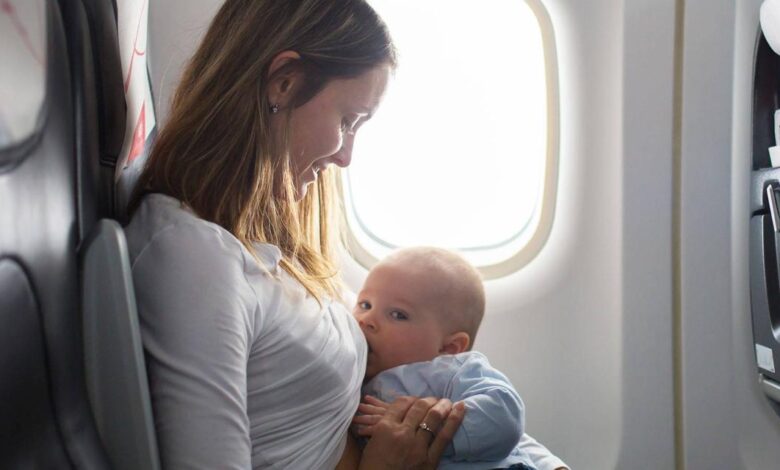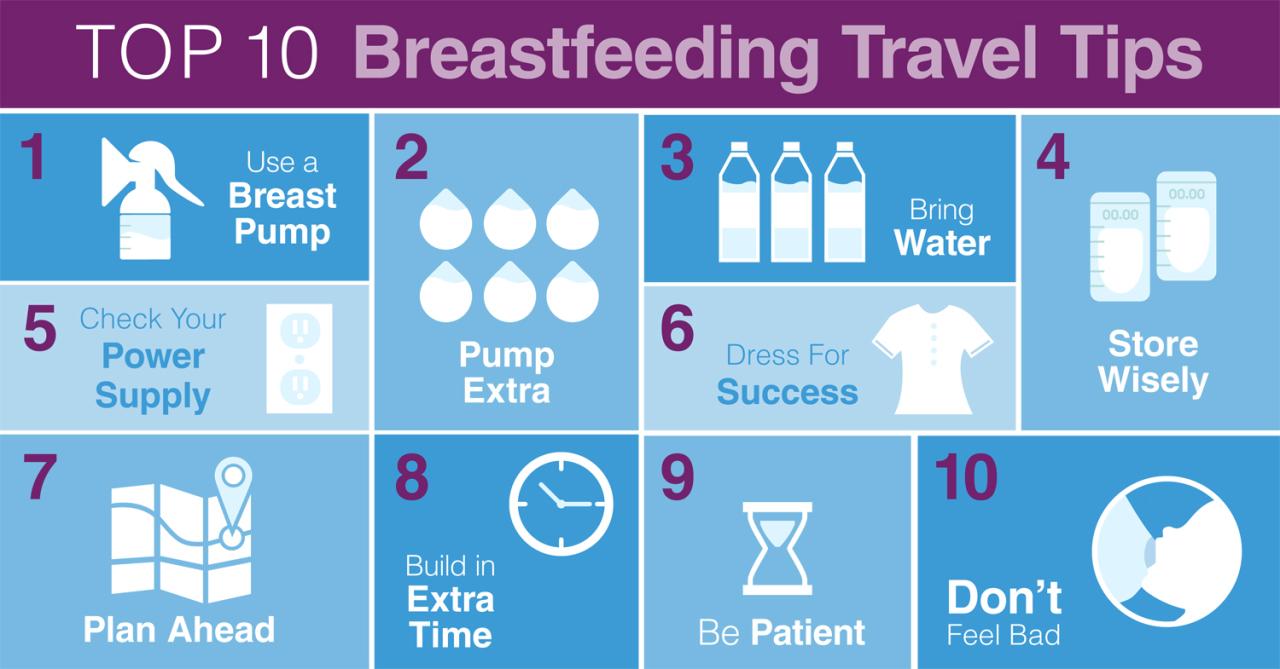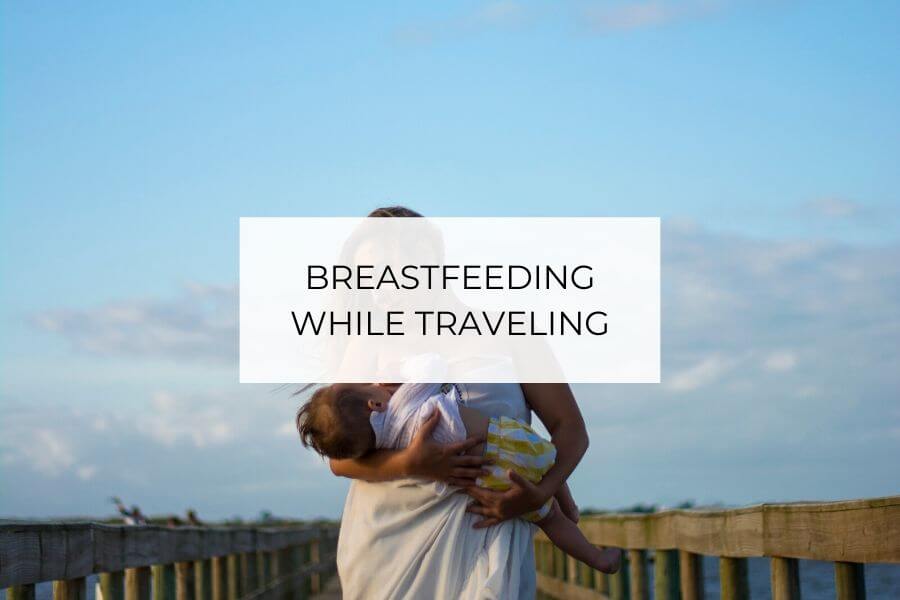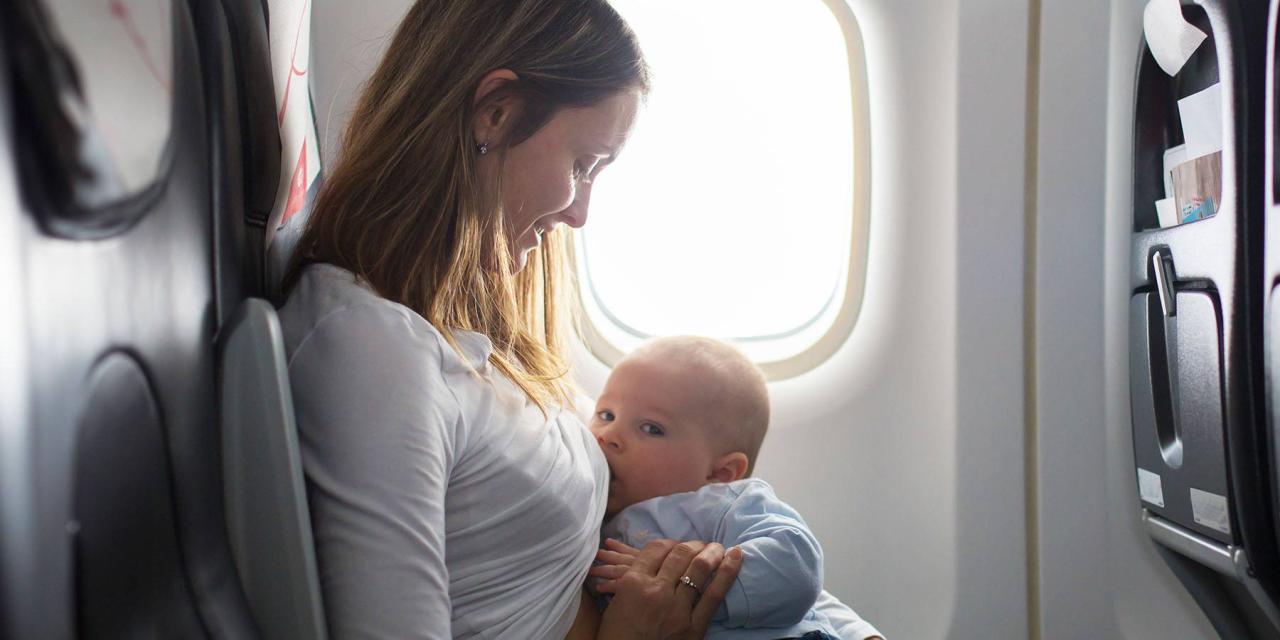
Breastfeeding Tips While Traveling
Breastfeeding tips while travelling – Breastfeeding tips while traveling? It might sound daunting, juggling a tiny human and a busy itinerary, but with a little planning, it’s totally doable! This post is your ultimate guide to making breastfeeding on the go smooth, stress-free, and even enjoyable. We’ll cover everything from packing essentials and finding comfortable nursing spots to managing your milk supply and staying healthy while you’re exploring new places.
Get ready to confidently embrace your adventures, mama!
Whether you’re hopping on a plane for a family vacation, taking a road trip, or just exploring a new city, breastfeeding while traveling requires a bit of preparation and know-how. This isn’t just about finding a quiet corner; it’s about maintaining your routine, ensuring your baby’s comfort, and taking care of yourself – all while experiencing the joy of travel.
This guide is designed to empower you with the tools and strategies you need for a successful and worry-free breastfeeding journey, no matter your destination.
Planning & Preparation Before the Trip

Source: prenate.com
Traveling while breastfeeding requires careful planning to ensure both you and your baby remain comfortable and healthy. A little preparation goes a long way in making your trip smooth and stress-free. This section focuses on essential pre-trip tasks to make breastfeeding on the go easier.
Essential Breastfeeding Supplies for Travel
Packing the right supplies is crucial for successful breastfeeding while traveling. Overpacking can be cumbersome, but underpacking can lead to unnecessary stress. A well-organized kit will help you manage your needs efficiently.
- Nursing bras (at least two, ideally more for longer trips).
- Nursing pads (to absorb leaks).
- Burp cloths (for inevitable spills).
- Breast milk storage bags (for storing expressed milk).
- Cooler bag with ice packs (to keep expressed milk cold).
- Small, portable hand sanitizer (for hygiene).
- Bottle or nursing system (if using one, along with cleaning supplies).
- Nursing cover (optional, for discretion).
- Any medications you regularly take (consult your doctor about travel suitability).
Safe and Efficient Breast Milk Packing
Proper storage of breast milk is vital to maintain its safety and nutritional value. Different methods cater to various trip durations and transportation modes.Maintaining a cold chain is key. This means keeping the milk consistently cold until it is used. For shorter trips, a cooler bag with ample ice packs is sufficient. For longer journeys or flights, consider using a portable cooler with reusable ice packs that can be replenished.
Remember to check the temperature regularly and replace ice packs as needed. For flights, pack your cooler bag as carry-on luggage to ensure consistent cold temperatures and prevent spoilage. When using breast milk storage bags, label them clearly with the date and time of expression.
Managing Milk Supply While Traveling
Changes in routine and environment can sometimes affect milk supply. Maintaining a regular nursing or pumping schedule, as much as possible, is key. Stay hydrated by drinking plenty of water throughout the day. Getting adequate rest is also essential for milk production. If you notice a dip in your milk supply, try relaxing and prioritizing your nursing or pumping sessions.
It’s perfectly normal for milk production to adjust temporarily due to stress or travel. If concerns persist, consulting a lactation consultant is advisable.
Packing nursing essentials for travel can be tricky, but prioritizing comfort is key! Remember to stay hydrated, which is also crucial for overall health, reducing risk factors like high blood pressure – one of the risk factors that make stroke more dangerous – that can affect everyone, even busy breastfeeding moms on the go. Finding time for self-care, including managing stress, will help you and your little one thrive on your journey.
Sample Breastfeeding Travel Itinerary
A sample itinerary can help you plan your trip effectively, incorporating time for nursing or pumping. This is just a suggestion, adjust it to your specific needs and travel schedule.
| Time | Activity | Breastfeeding/Pumping Note |
|---|---|---|
| 7:00 AM | Wake up, nurse baby | First feeding of the day |
| 8:00 AM | Breakfast | Quick and easy meal |
| 9:00 AM – 12:00 PM | Travel | Plan nursing stops or express milk beforehand |
| 12:00 PM | Lunch | Find a quiet spot to nurse or pump |
| 1:00 PM – 4:00 PM | Activities | Plan nursing or pumping breaks as needed |
| 4:00 PM | Snack and nurse | Keep baby happy and hydrated |
| 7:00 PM | Dinner | Another opportunity for a nursing session |
| 8:00 PM | Bedtime routine, nurse baby | Last feeding of the day |
Breastfeeding on the Go

Source: tori-leigh.com
Traveling with a baby can be challenging, but breastfeeding on the go doesn’t have to add to the stress. With a little planning and the right techniques, you can comfortably and discreetly nurse your little one wherever your journey takes you. This section focuses on making breastfeeding convenient and manageable during different modes of transportation and in various public settings.
Comfortable Breastfeeding Positions for Various Transportation Modes
Finding a comfortable breastfeeding position while traveling requires adaptability. On a plane, a nursing pillow can provide crucial support, even in a cramped seat. Consider using a nursing cover for added privacy. In a car, you can utilize a nursing pillow or even simply lean back and support your baby against your body. Trains offer more space than planes, allowing for more flexibility in positioning.
You might find a window seat particularly helpful for leaning against and offering some visual privacy. Remember, the key is to find a position that supports both you and your baby while minimizing discomfort and maximizing safety.
So, you’re breastfeeding and planning a trip? Packing breast milk storage bags is key! It’s all about planning ahead, just like Karishma Mehta did when she decided to freeze her eggs – check out this article on the risks involved: karishma mehta gets her eggs frozen know risks associated with egg freezing. Making informed choices about your reproductive health is crucial, much like choosing the right nursing bra for comfortable travel.
Happy travels!
Strategies for Discreet Breastfeeding in Public Spaces
Discreet breastfeeding is achievable with a few simple strategies. A nursing cover or wrap provides a physical barrier, offering privacy while still allowing you to maintain eye contact with your baby. Positioning yourself strategically—near a wall or in a less-populated area—can also help. Remember, you have the right to breastfeed in public, but employing these strategies can help you feel more confident and comfortable.
Many nursing mothers find that wearing loose, comfortable clothing that allows easy access also aids in discreet breastfeeding.
Maintaining Hygiene and Sanitation While Breastfeeding During Travel
Maintaining hygiene while breastfeeding on the go is paramount. Carry hand sanitizer and use it frequently, especially before and after nursing. If access to a sink is available, wash your hands thoroughly with soap and water. Using disposable nursing pads can help prevent leaks and maintain cleanliness. Consider packing breast milk storage bags and a cooler bag to store expressed milk safely if you anticipate challenges with direct breastfeeding.
Cleanliness reduces the risk of infection for both you and your baby.
Comparison of Breastfeeding Covers or Wraps
Choosing the right breastfeeding cover or wrap can significantly impact your comfort and experience. The following table compares some popular options:
| Cover/Wrap Type | Advantages | Disadvantages | Suitability |
|---|---|---|---|
| Nursing Scarf | Versatile, lightweight, can be worn as a fashion accessory. | May not offer complete coverage, can be tricky to adjust. | Suitable for warmer climates and less-private settings. |
| Nursing Cover with Structured Hood | Offers excellent coverage, often features a wide opening for baby access. | Can be bulky, may feel warmer than a scarf. | Ideal for colder climates and more-private settings. |
| Nursing Poncho | Provides ample coverage, comfortable and stylish. | Can be cumbersome to pack, may not be suitable for all seasons. | Good for all-around use, offering both style and functionality. |
| Simple Muslin Cloth | Lightweight, breathable, easy to pack and clean. | Offers less coverage than structured covers, requires more practice to use effectively. | Best for those who prefer a simple, lightweight solution. |
Breastfeeding in Different Environments
Traveling with a baby, especially while breastfeeding, presents unique challenges. Adapting your breastfeeding routine to unfamiliar surroundings requires planning and flexibility. This section focuses on navigating various environments and climates, ensuring comfortable and successful breastfeeding experiences on the go.
Breastfeeding in Airports, Hotels, and Other Unfamiliar Locations
Airports and hotels, while offering some amenities, often lack designated breastfeeding spaces. Preparation is key to navigating these environments successfully. Consider carrying a lightweight nursing cover for discreet breastfeeding in public areas. Many airports now have designated family rooms or quiet areas; familiarize yourself with their locations beforehand using airport websites or apps. Hotels sometimes offer similar amenities; check with the front desk upon arrival.
If no designated space is available, a restroom stall can serve as a last resort, though it may not be ideal. Remember to pack hand sanitizer and wipes for hygiene.
Managing Breastfeeding in Varying Climates and Temperatures
Extreme temperatures can impact both you and your baby’s comfort during breastfeeding. In hot climates, staying hydrated is crucial for milk production. Dress in lightweight, breathable clothing and seek out air-conditioned spaces whenever possible. For cooler temperatures, layer clothing to maintain warmth and ensure your baby is adequately dressed. A warm scarf or shawl can provide extra comfort during feeding.
Remember to monitor your baby for signs of overheating or chills, adjusting clothing and environment as needed. For example, a light cotton shawl can provide warmth without overheating the baby in a moderately cool environment.
Strategies for Finding Private and Comfortable Spaces for Breastfeeding in Public Places
Finding a private and comfortable space for breastfeeding can be challenging. Planning ahead is essential. Before leaving home, identify potential breastfeeding-friendly locations along your route, such as cafes known for their family-friendly atmosphere, libraries with quiet corners, or even designated nursing rooms in larger stores. A nursing cover can also offer a sense of privacy in less-than-ideal locations.
If you feel uncomfortable breastfeeding in public, consider expressing milk beforehand and feeding your baby expressed milk from a bottle.
Handling Potential Challenges Like Time Zone Changes and Disrupted Routines
Time zone changes can disrupt both your baby’s and your own sleep patterns, potentially affecting breastfeeding. Try to maintain a consistent feeding schedule as much as possible, adjusting gradually to the new time zone. Listen to your baby’s cues and offer feedings on demand. Pack snacks and drinks for yourself to maintain your energy levels, as fatigue can impact milk production.
For example, a family traveling from New York to London might aim to shift their baby’s feeding schedule by an hour each day to adapt to the five-hour time difference. This gradual adjustment minimizes disruption and helps maintain a consistent breastfeeding routine.
Nutrition and Hydration for the Breastfeeding Mother
Traveling while breastfeeding can be challenging, but maintaining a healthy diet and staying hydrated is crucial for both your well-being and your baby’s. Your nutritional intake directly impacts your milk supply and your energy levels, which are already taxed by the demands of travel. Prioritizing nutrition and hydration is key to a smoother and more enjoyable trip.
Nutritious and Easy-to-Pack Snacks and Meals
Planning ahead is essential for ensuring you have access to nutritious food while traveling. Packing healthy snacks and meals eliminates the reliance on potentially less-than-ideal options at airports or rest stops. Remember to choose foods that are non-perishable or easy to keep cool with portable coolers or ice packs.
- Whole-grain crackers and cheese: Provides complex carbohydrates, protein, and calcium.
- Trail mix: A mix of nuts, seeds, and dried fruit offers healthy fats, protein, and fiber.
- Granola bars: Choose bars with minimal added sugar and a good balance of whole grains and nuts.
- Fruit (apples, bananas, oranges): Easy to pack and naturally sweet.
- Hard-boiled eggs: A great source of protein.
- Yogurt tubes: Convenient and packed with protein and calcium (ensure they are kept cold).
- Pre-portioned oatmeal packets: Easy to prepare with hot water.
Staying Hydrated While Breastfeeding and Traveling
Dehydration can significantly impact milk production and leave you feeling fatigued. Breastfeeding itself increases your fluid requirements, and the added stress of travel can exacerbate this. Therefore, consistent hydration is paramount.
Strategies for staying hydrated include:
- Carrying a reusable water bottle and refilling it frequently.
- Drinking water before, during, and after flights or long car rides.
- Consuming hydrating beverages like coconut water or herbal teas (caffeine should be moderated).
- Eating fruits and vegetables with high water content, such as watermelon or cucumbers.
- Setting reminders on your phone to drink water throughout the day.
Managing Dietary Restrictions or Allergies While Traveling and Breastfeeding, Breastfeeding tips while travelling
Managing dietary restrictions or allergies while breastfeeding and traveling requires careful planning and preparation. Knowing your restrictions and communicating them clearly to those around you is crucial. Researching dining options beforehand can also alleviate stress.
Packing for a breastfeeding trip? Don’t forget your nursing cover and extra supplies! It’s amazing how advancements in medicine continue to amaze me, like the news I read about the fda approves clinical trials for pig kidney transplants in humans – truly groundbreaking! Anyway, back to breastfeeding on the go – finding a comfortable spot and staying hydrated are key for both you and baby.
Specific strategies include:
- Carrying a list of your allergens and any potential cross-contamination concerns.
- Packing safe snacks and meals to avoid relying solely on restaurant options.
- Using translation apps to communicate your dietary needs in foreign countries.
- Contacting hotels or accommodations in advance to inquire about allergy-friendly options.
Maintaining a Balanced Diet to Support Milk Production During Travel
A balanced diet is crucial for maintaining a healthy milk supply. While traveling, it’s easy to fall into unhealthy eating habits, but prioritizing a variety of nutrient-rich foods will help ensure you’re meeting your and your baby’s nutritional needs.
Focus on consuming a range of:
- Fruits and vegetables: Provide essential vitamins and minerals.
- Whole grains: Offer sustained energy and fiber.
- Lean protein: Supports milk production and overall health.
- Healthy fats: Crucial for brain development in your baby.
- Calcium-rich foods: Important for bone health for both you and your baby.
Addressing Potential Challenges
Traveling with a breastfeeding baby can present unique hurdles, but with preparation and a positive attitude, many challenges can be mitigated. This section will address common difficulties and offer practical solutions to ensure a smoother breastfeeding journey while exploring new places.
Common Challenges and Solutions
Travel often disrupts routines, and breastfeeding is no exception. Unexpected situations can arise, impacting both mother and baby. The following Artikels common challenges and provides effective solutions.
- Difficulty Finding a Private Space: Discreet nursing can be challenging in busy airports, restaurants, or tourist attractions. Solutions include using nursing covers, finding quiet corners, or utilizing nursing rooms (often found in airports and larger shopping malls). A lightweight, portable nursing scarf offers privacy and warmth.
- Time Zone Changes: Jet lag affects both mother and baby, potentially impacting feeding schedules and milk supply. Maintaining a consistent nursing routine as much as possible, even if it means adjusting to the new time zone gradually, helps minimize disruption. Following the baby’s cues and offering frequent feeds are key.
- Changes in Diet and Hydration: Access to familiar foods and sufficient hydration can be limited while traveling. Packing healthy snacks and staying hydrated are crucial. Dehydration can directly impact milk supply, so carrying a reusable water bottle and prioritizing water intake is essential.
- Stress and Anxiety: The stress of travel can affect milk supply. Practicing relaxation techniques like deep breathing exercises or meditation can help manage stress. Seeking support from a travel companion or reaching out to a lactation consultant virtually can provide emotional support.
- Dealing with Oversupply or Undersupply: Travel-related stress and changes in routine can sometimes lead to fluctuations in milk supply. For oversupply, regular and complete emptying of breasts is vital. For undersupply, increasing skin-to-skin contact and frequent nursing sessions can stimulate milk production. A lactation consultant can provide personalized advice.
Coping Mechanisms for Stress and Anxiety
The unpredictable nature of travel can be stressful for breastfeeding mothers. Implementing coping strategies is vital for maintaining well-being and ensuring a positive breastfeeding experience.
Prioritizing self-care is crucial. This includes getting enough rest whenever possible, practicing mindfulness techniques like meditation or deep breathing, and seeking support from family, friends, or a support group. Packing comfort items, such as a favorite book or calming essential oils, can also help manage stress during travel. Remembering to prioritize self-care will help reduce anxiety and maintain milk supply.
Managing Milk Supply Fluctuations
Travel-related disruptions can cause temporary fluctuations in milk supply. Maintaining a consistent nursing routine, even with schedule changes, helps regulate milk production.
Staying well-hydrated, eating a balanced diet, and managing stress are vital for consistent milk supply. If significant fluctuations occur, consulting a lactation consultant can provide personalized guidance and address any underlying concerns. Remember that temporary supply changes are common, and many strategies can help mitigate them.
Handling Unexpected Situations
Lost or damaged breastfeeding supplies can be a significant inconvenience. Packing extra supplies, such as nursing pads, bottles, and storage bags, can minimize disruption.
Consider carrying a small, reusable nursing bag with essential supplies in your carry-on luggage. If supplies are lost or damaged, contacting the airline or hotel may provide assistance in replacing them. Knowing where to find support, such as local lactation consultants or support groups, is also helpful in unexpected circumstances.
Illustrative Examples
Traveling with a breastfeeding baby presents unique challenges, but with careful planning and preparation, these hurdles can be overcome. This section provides real-world examples to illustrate effective strategies for managing breastfeeding while traveling.
Breastfeeding on a Plane
Sarah, a first-time mother, recently flew cross-country with her three-month-old baby, Liam. She was initially apprehensive about breastfeeding at 30,000 feet. Her biggest concern was finding a comfortable and private space. To prepare, Sarah contacted the airline beforehand to inquire about designated nursing areas or quiet spaces. While the airline didn’t have a designated area, they suggested using the family restroom, which was relatively spacious and offered some privacy.
During the flight, she timed Liam’s feedings to coincide with periods of less turbulence. She brought a nursing cover for added privacy and a small, lightweight blanket for warmth. She also packed extra nursing pads, anticipating potential leaks. While Liam was fussy during takeoff and landing due to pressure changes, Sarah successfully breastfed him throughout the flight, utilizing the family restroom for longer feedings and discreetly nursing under her cover in her seat during calmer periods.
She found that bringing familiar comfort items, like Liam’s favorite stuffed animal, helped soothe him and made the process easier. The experience, while initially daunting, proved manageable thanks to her proactive planning and adaptable approach.
Breastfeeding-Friendly Hotel Room Setup
A breastfeeding-friendly hotel room should prioritize comfort and privacy. Imagine a room with a comfortable armchair or a supportive nursing chair positioned near an electrical outlet for a breast pump. A side table next to the chair could hold essentials like nursing pads, water bottles, snacks, and a burp cloth. Adequate lighting, ideally a soft lamp rather than harsh overhead lighting, is crucial for nighttime feedings.
For privacy, consider a room with blackout curtains to minimize distractions and ensure a peaceful environment for both mother and baby. A changing mat or a comfortable surface for diaper changes near the nursing area would further enhance the functionality of the space. A mini-refrigerator for storing expressed milk is also essential. The entire setup should feel cozy, clutter-free, and conducive to relaxed and successful breastfeeding sessions.
Storing and Transporting Breast Milk
Safe storage and transportation of breast milk are critical to maintain its quality and safety. Several options exist, each with its own specifications. For short-term storage (less than 4 hours), a clean, insulated cooler bag with ice packs can be used. For longer trips, a hard-sided cooler with ample ice packs or frozen gel packs is preferable. Breast milk can be stored in sterile, BPA-free plastic bags specifically designed for breast milk storage, which are lightweight and easy to transport.
Alternatively, glass or hard plastic bottles are suitable, but they are heavier and less flexible than bags. These containers should be clearly labeled with the date and time of expression. When transporting breast milk by air, it’s recommended to keep it in a cooler bag with ice packs and place it in the carry-on luggage to avoid temperature fluctuations during transit.
Remember to always check with the airline regarding their regulations on transporting breast milk. Properly labeled and cooled breast milk can typically be safely stored for up to 24 hours in a cooler bag with ice packs.
Ending Remarks

Source: com.au
So there you have it – your comprehensive guide to breastfeeding while traveling! Remember, planning ahead and embracing flexibility are key. Don’t be afraid to ask for help, and most importantly, trust your instincts. Traveling with a nursing baby is an incredible experience; with the right preparation, you can enjoy every moment without the added stress. Happy travels, mamas!
Questions and Answers: Breastfeeding Tips While Travelling
What if my baby refuses to breastfeed in a new environment?
Try to recreate a familiar and calming atmosphere. Use a familiar blanket or toy, and keep things as quiet and dark as possible. Sometimes a change in position can help too.
How do I handle jet lag and its impact on my milk supply?
Stay hydrated, eat well, and try to maintain a regular feeding schedule as much as possible. Your body will adjust, but be patient with yourself and your baby.
What if I run out of nursing pads or other supplies?
Many pharmacies and convenience stores carry basic nursing supplies. In a pinch, clean cloths can work as makeshift pads. Always prioritize hygiene.
Can I breastfeed on a plane?
Yes, absolutely! Many airlines are very accommodating. It’s often easiest to nurse during takeoff and landing to help your baby’s ears adjust to pressure changes. Be sure to check airline policies ahead of time.
